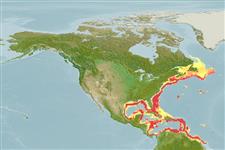>
Gadiformes (Cods) >
Moridae (Morid cods)
Etymology: Laemonema: Greek, laimos = throat + Greek, nema = filament (Ref. 45335).
More on authors: Goode & Bean.
Environment: milieu / climate zone / depth range / distribution range
Écologie
marin benthopélagique; profondeur 50 - 1620 m (Ref. 31160). Subtropical; 57°N - 4°N, 98°W - 43°W
Western Atlantic: Canada to French Guiana.
Taille / Poids / Âge
Maturity: Lm ? range ? - ? cm
Max length : 33.0 cm SL mâle / non sexé; (Ref. 5951)
Épines dorsales (Total) : 0; Rayons mous dorsaux (Total) : 69 - 76; Épines anales: 0; Rayons mous anaux: 57 - 63. Body low and slender with small deciduous scales (Ref. 31160). Upper jaw reaching below middle of eye; teeth on jaws forming a band, outer series enlarged; first dorsal fin ray produced; anterior part of anal fin elevated; no distinct blackish mark on posterior end of dorsal and anal fins (Ref. 13608) - last phrase conflicting with Ref. 31160.
Life cycle and mating behavior
Maturities | Reproduction | Spawnings | Egg(s) | Fecundities | Larves
Meléndez, C., R. and D.F. Markle, 1997. Phylogeny and zoogeography of Laemonema and Guttigadus (Pisces: Gadiformes: Moridae). Bull. Mar. Sci. 61(3):593-670. (Ref. 31160)
Statut dans la liste rouge de l'IUCN (Ref. 130435)
Menace pour l'homme
Harmless
Utilisations par l'homme
Outils
Articles particuliers
Télécharger en XML
Sources Internet
Estimates based on models
Preferred temperature (Ref.
123201): 4.5 - 16.9, mean 10.5 °C (based on 224 cells).
Phylogenetic diversity index (Ref.
82804): PD
50 = 0.5000 [Uniqueness, from 0.5 = low to 2.0 = high].
Bayesian length-weight: a=0.00363 (0.00215 - 0.00613), b=3.14 (2.99 - 3.29), in cm total length, based on LWR estimates for this species & (Sub)family-body (Ref.
93245).
Niveau trophique (Ref.
69278): 3.5 ±0.5 se; based on size and trophs of closest relatives
Résilience (Ref.
120179): Faible, temps minimum de doublement de population : 4,5 à 14 années (Preliminary K or Fecundity.).
Fishing Vulnerability (Ref.
59153): Low to moderate vulnerability (30 of 100).
